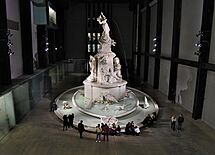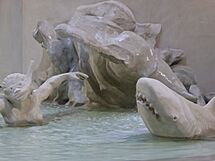Kara Walker facts for kids
Kara Elizabeth Walker (born November 26, 1969) is an American artist known for exploring big ideas like race, gender, and identity in her work. She is a painter, printmaker, installation artist, and filmmaker. Walker is most famous for her large, room-sized artworks made from black cut-paper silhouettes.
In 1997, when she was 28, Walker received a MacArthur fellowship, often called a "genius grant." She is considered one of the most important Black American artists working today. Since 2015, she has been a professor at the Mason Gross School of the Arts at Rutgers University.
Contents
Early life and education
Kara Walker was born in Stockton, California, in 1969. Her father, Larry Walker, was also an artist and professor. Her mother, Gwendolyn, was an administrative assistant. Walker's early childhood in a diverse California suburb was calm.
When Walker was 13, her family moved to Stone Mountain, Georgia, after her father took a job at Georgia State University. This move was a big change for her. Unlike her home in California, Stone Mountain was a place where groups like the Ku Klux Klan still held rallies. At her new high school, Walker experienced racism for the first time.
Walker earned her first art degree from the Atlanta College of Art in 1991. She then received her master's degree from the Rhode Island School of Design in 1994. At first, she was hesitant to make art about race. But during her master's program, she began to explore these important themes in her work.
Walker was inspired by her father from a very young age. She once said, "One of my earliest memories involves sitting on my dad's lap in his studio... and watching him draw. I remember thinking: 'I want to do that, too,' and I pretty much decided then and there at age 2½ or 3 that I was an artist just like Dad."
Art and career
Walker is famous for her large scenes made of cut-paper silhouettes. These are typically black paper shapes placed on a white wall. Her art tells stories about the history of American slavery and racism using powerful and sometimes shocking images. She also creates art using watercolor paints, video animation, and huge sculptures.
Her silhouettes take a classic art form, often used for polite family portraits, and turn it into something new. She uses them to create a world that shows the harsh realities of American history and racism.
Walker became well-known in the art world in 1994 with her mural titled "Gone, An Historical Romance of a Civil War...". This artwork, made of cut-paper silhouettes, showed a story about the Antebellum South (the period before the American Civil War). It quickly made her famous.
Her work is influenced by artists like Andy Warhol and Robert Colescott. Walker's art often focuses on the experiences of African-American women, exploring issues of identity and history.
How she creates her art
Walker's silhouette installations are designed to make you feel like you are inside the artwork. The scenes often wrap around the room, similar to a 360-degree painting called a cyclorama, which was popular in the 1800s. This makes the viewer feel surrounded by the story she is telling.
She once described her creative process as “two parts research and one part paranoid hysteria.” This means she spends a lot of time studying history, but also uses her own feelings and imagination to create her powerful art.
Important artworks
- Insurrection! (Our Tools Were Rudimentary, Yet We Pressed On) (2000): In this piece, Walker projected colored lights onto her silhouettes. This made the viewers' own shadows become part of the artwork, making them feel connected to the difficult themes.
- A Subtlety, or the Marvelous Sugar Baby (2014): This was a giant sculpture displayed in an old sugar factory in Brooklyn, New York. The main piece was a 75-foot-long sculpture of a woman shaped like a sphinx. It was made from white sugar. The artwork was a tribute to the unpaid workers on sugar plantations. It was a very popular exhibit, attracting over 130,000 visitors.
- Fons Americanus (2019): This was a 43-foot-tall fountain installed in the Tate Modern museum in London. The fountain was inspired by a monument in front of Buckingham Palace. But instead of celebrating an empire, Walker's fountain told the story of the Atlantic slave trade and the histories of Africa, America, and Europe.

Controversy
Walker's art is meant to make people think and talk about difficult subjects. Because her work deals with racism and history in a direct way, it has sometimes caused controversy.
Some older African-American artists, like Betye Saar, have criticized Walker's work. They felt her use of certain images was negative. In 1997, Saar sent emails to other artists to express her concerns. This led to a conference at Harvard University in 1998 to discuss the use of racist imagery in art.
In 2012, one of Walker's artworks at the Newark Public Library caused a debate among the staff because of its challenging images. Walker visited the library to talk about the artwork. She explained that her goal is to start a conversation about history and racism, even when it's uncomfortable.
Recognition and awards
- In 1997, Walker won a MacArthur fellowship at age 28, making her one of the youngest winners ever.
- In 2007, Time magazine named her one of the 100 Most Influential People in the World.
- In 2012, she was elected to the American Academy of Arts and Letters.
- In 2019, she was elected to the Royal Academy of Arts in London.
Personal life
Walker married Klaus Bürgel, a jewelry professor, in 1996. They have a daughter, who was born in 1997. The couple later separated and their divorce was finalized in 2010. In 2025, Walker married photographer and filmmaker Ari Marcopoulos.
Since 2003, Walker has lived in Brooklyn, New York. She is a professor of visual arts at Columbia University. She has an art studio in Brooklyn and also owns a home in rural Massachusetts.
Images for kids
See also
 In Spanish: Kara Walker para niños
In Spanish: Kara Walker para niños




